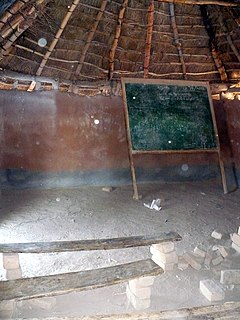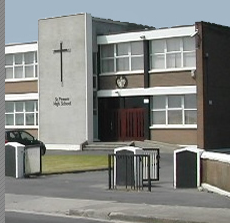
Luanshya is a town in Zambia, in the Copperbelt Province near Ndola. It has a population of 117,579.
Rice Memorial High School is a coeducational Roman Catholic secondary and college preparatory school in South Burlington, Vermont. It is located in the Roman Catholic Diocese of Burlington. The student body is mostly drawn from Northern and Central Vermont but includes other students including international students. The school and buildings were named for Bishop Joseph Rice who had established Cathedral High School in 1917. Base tuition per student, which excludes certain additional fees that currently apply such as $150 registration fee, and $200 student activity fee, has been set at $10,865 for 2019-2020.
Mainza Mathias Chona was a Zambian politician and diplomat who served as the third vice president of Zambia from 1970 to 1973 and Prime Minister on two occasions: from 25 August 1973 to 27 May 1975 and from 20 July 1977 to 15 June 1978.
Munali Secondary School is a state-funded secondary school located on the Great East Road, just outside Lusaka, Zambia. Munali was the first secondary school for black students in Zambia's history. Some of its alumni are notable Zambian politicians and public figures:

Lower education in Zambia is divided into three levels and these are namely: primary, junior secondary and upper secondary. Higher education in Zambia has improved in the recent years due to the increase of private universities and colleges. The biggest university is the public University of Zambia which is located in the capital city of Lusaka along the great east road and hosts a number of local and international students. The Copperbelt university is the second largest public university and is located in the Copperbelt province of Zambia in Kitwe.There are many other smaller universities, both public and private including the following; Texila American University, Zambia Open University, European University Zambia Zambia Catholic University, Cavendish University, Zambia Adventist University, Northrise University, University of Lusaka, Lusaka Apex Medical University, Woodlands University College, Copperstone University College, University of Barotseland, University of Africa, Information and Communication University, Mulungushi University, Kwame Nkrumah University of Education, Chalimbana university, Rusangu University, Robert Makasa University, Zambia Centre of Accountancy Studies and there are various Health training Institutes offering Diplomas in clinical medicine, Registered Nursing

Chizongwe Secondary School is a secondary (technical) school located north of Chipata, Eastern Province, Zambia. It was founded in the 1950s as Fort Jameson Trades School. It is the only technical school in Eastern Province.
St. Stephen's College, Balla Balla, Southern Rhodesia was a private Christian high school for boys from 1956 to 1975.

The following outline is provided as an overview of and topical guide to Zambia:

St. Fintans High School is an all-boys Roman Catholic voluntary-aided secondary school located between Sutton and Baldoyle, Dublin, Ireland.
Rugby union in Zambia is a minor but growing sport. The Zambia national rugby union team is currently ranked 67th by World Rugby. The Zambia Rugby Football Union has 9880 registered players and three formally organised clubs.

Kaiser Kalambo was a Zambian coach and former footballer. He represented Zambia in three African Cup of Nations tournaments and was named Zambian captain in 1980, the same year in which he was voted Zambian footballer of the year. He later coached several club sides in Zambia and Botswana.
Dickson Kenneth Makwaza was a Zambian football player and coach. Nicknamed "Barbed-Wire" due to his tenacity in defence, he was one of the most decorated players in Zambian soccer history and was captain of the Zambian national team that made its first ever appearance at the African Cup of Nations tournament in Egypt in 1974. Makwaza also captained Mufulira Wanderers and was voted Zambian footballer of the year in 1973. He later coached Wanderers and several other club sides.
Philip Peyala, popularly known as Philip Sabu is a former Zambian goalkeeper. Popular with fans because of his acrobatics between the posts, Sabu was in the Zambia national team at independence in October 1964.
The history of the Baháʼí Faith in Zambia began in 1952 with the arrival of a British pioneer named Eric Manton. The first local convert was Christopher Mwitumwa in 1954. The Baháʼí Faith has expanded considerably in Zambia since then; some estimates have put the Baháʼí population in Zambia as high as 241,112, though the Zambian Baháʼí community itself and UNdata have estimated around 4,000 adherents. The Baháʼí community of Zambia oversees several social initiatives, for instance in education with an emphasis on girls' education.

Kapelwa Sikota (1928–2006) was the first Zambian registered nurse, in the 1950s when her country was still the British protectorate of Northern Rhodesia. She trained and qualified in South Africa where nursing education was available before it was developed in Zambia. Her qualifications were not fully recognised at home until independence in 1964 when she was appointed to senior nursing posts. By 1970 she was Chief Nursing Officer in the Ministry of Health. In 2011 she was honoured posthumously by the Zambian Association of University Women.
Happy Malama is a former Zambian goalkeeper who played for Roan United and was in goal in Zambia’s first ever World Cup qualifier against Sudan in October 1968. He is often mistaken for Innocent “Mummy” Malama, another goalkeeper who featured for the national team prior to Zambia’s independence. In 1970, Malama moved from Roan to Chibuku Warriors for what was then the record transfer fee in Zambian football.
Sikota Wina is a Zambian former politician. He was a member of the Legislative Council and the National Assembly and the country's first Minister of Health. He also held the posts of Minister for Local Government and Minister of Information, Broadcasting and Tourism.
Kitwe Boys Secondary Schoolwas built in the year 1957 in Kitwe, Zambia. During that time the school was only for whites before Zambia became independent in the Year 1964. The head master was Mr J Hall. It is located in Kitwe park lands near Kitwe Central Hospital.

Roan Antelope is a copper mine in Zambia. The deposits were discovered in 1902, but their full extent was not understood until 1926. The mine site was developed between 1927 and 1931, at first experiencing many deaths from malaria due to poor drainage. Production since then has experienced various slumps and booms. The mine was nationalized in 1970 and returned to private ownership in 1997. The new owners struggled to make it profitable, and it changed hands twice.
John “Ginger” Pensulo was a former Zambian footballer and coach. A key player for Roan United, he led the club to the Zambian league title in its inaugural season in 1962 and was one of the men behind the team's fluid style of play, being involved in various coaching roles.






